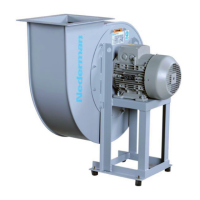NCFEN
24
When starng the fan for the rst me, the following preliminary checks are necessary:
• Check that all bolts are correctly ghtened (impeller, supports, foundaon bolts, and
transmission components).
• Check that the impeller can turn freely.
• Check that there are not foreign objects inside the fan.
• Check that the fan turns in the correct direcon: power the motor for a brief moment
to see if it turns in correct direcon indicated by the arrow on the fan housing; if
necessary, invert the direcon of rotaon (see Secon
4.5.3. Electrical connecons).
4.7.2 Checks to be carried out with the fan running
Check that the power absorpon does not exceed the value indicated on the motor
idencaon plate, if it does; stop the fan immediately and contact the manufacturer.
The fan must run without excessive vibraon and noise.
Check, with the fan at rest and at an outside air temperature of 20°C, that the bearings do
not exceed the maximum operang temperature (maximum bearing temperature 70°C).
During the rst few hours of operaon, it is normal for the bearings to reach slightly higher
temperatures, as long as they later stabilise at a lower value. In the event of overheang of
the bearings, contact the Nederman technical assistance department.
Aer 3 - 4 operang hours, with the fan at rest and disconnected from the power supply,
check again that all bolts are correctly ghtened and the bearing temperature.
4.7.3 Visual checks on guards
CAUTION! Risk of equipment damage.
• All guards must be inspected every month and replaced if necessary.
• In case of doubts, carry out checks more frequently or replace the guard.
For mesh guards, checks must be made for the following:
• Corrosion or dullness of galvanized surfaces
• Detachment of rivets/welds
• Evidence of noises typical of loose guards
• Impacts and permanent deformaon of components
• Breakage of wires
• Corrosion of fasteners
• Slackening of xing elements
For guards in pressed and painted sheet metal, checks must be made for the following:
• Corrosion or dullness of painted surfaces
• Detachment of rivets/welds
• Evidence of noises typical of loose guards
• Impacts and permanent deformaon of components
• Mechanical deformaon or breakage of guards
• Presence of cracks
• Corrosion of fasteners
• Slackening of xing elements

